Local Scour around Tandem Double Piers under an Ice Cover
Abstract
:1. Introduction
2. Experiment Setup and Methodology
2.1. Experimental Setup
2.2. Experiment Procedure
- (1)
- Before each experiment started, the sand bed was leveled, and the slope was maintained at 0 degrees (horizontal) by using a scraping plate. The test pier was installed in the center of the flume at cross section 16.
- (2)
- Afterward, the flume was slowly filled with water to avoid the initial scour of channel bed. When the water level in the flume reached the designated position, the water filling process was finished.
- (3)
- Then, the model ice cover was carefully placed on the water surface. With this step, the preparation for this experiment was completed.
- (4)
- To start each experiment run, a designated discharge through the triangle weir from the water holding tank was kept as a constant. The head (water surface) over the triangular weir was controlled by a point gauge with an accuracy of 0.1 mm. The water level in the flume was maintained at a designated level by adjusting the tailgate at the downstream end of the flume. Under such a flow condition, this set of experiments was kept running.
- (5)
- At CS-16 where the pier is located, both scour depth and water levels at each cross section were measured once every two minutes during the first half hour, once every five minutes during the 2nd half hour, once every 10 min during the 3rd half hour, and finally, once every 30 min until the end of each experiment run. Experiments showed that after about 6 h, no significant changes in the scouring process and the quasi-equilibrium depth of the scour hole were achieved. However, all experiment runs lasted 16 h to ensure that the local scour process around the tandem double piers reached an equilibrium state. Under such an equilibrium condition, the shape of the deposition dune does not change since the scour process at tandem double piers stops completely, although some sand particles reciprocate inside scour holes but cannot be washed out of scour holes. Then, the model ice cover was removed carefully. By reducing the incoming flow rate from the upstream water holding tank, and increasing the water level by raising the tailgate, the flow velocity in the flume was kept basically at a standstill. Thus, the shape of the scour hole did not change. Then, the bathymetry of the scour hole and deposition dune around the pier was measured by using a point gauge with the accuracy of 0.1 mm. In total, for each survey of the bathymetry of the scour hole and deposition dune, the measurements were conducted at 48 points, including inside the scour hole, along the middle ridge line of the mound, and the outer contour line of the mound. Some variables used in this study are defined and shown in Figure 2.
3. Results and Discussions
3.1. Analysis of Experiment Data
3.2. Empirical Expression for Calculating Scour Depth
4. Conclusions
- Under an ice-covered flow condition, the patterns of local scour around the tandem double piers depends on the spacing distance between the piers. If the spacing distance between the piers is zero, the local scour process around the tandem double piers should be treated as a single pier scour. With the increase in the spacing distance between piers, the scour depth around the front pier under an ice-covered flow condition increases by about 10% compared to that under a single pier case. Moreover, with the increase in the pier spacing ratio, the scour depth around the front pier will gradually decrease. When the pier spacing ratio L/D = 5, sediment scoured at the front pier begins to deposit between these two piers. To initiate a deposition dune between piers, the pier spacing distance under an ice-covered condition is about 20% more than that under an open flow condition. The existence of the rear pier will increase the length of the scour hole but reduce the depth of the scour hole around the front pier. The maximum scour depth around the rear pier increases first, then decreases and increases again afterward. When the pier spacing ratio L/D = 9, the local scour depth around the rear pier is the least. With the increase in the pier spacing ratio, the influence of the local scour around the front pier on the local scour around the rear pier gradually decreases. When the pier spacing ratio L/D is more than 17, the local scour around the front pier has hardly any influence on that around the rear pier. The scour depth around the rear pier is about 90% of that around the front pier.
- Under the same experimental conditions, compared with the results of local scour around a single pier, when the pier spacing ratio L/D > 4.5, the height of the deposition dune downstream of the front pier is lower, but the length of the deposition dune downstream of the front pier is longer. Both the height and length of the deposition dune downstream of the rear pier are smaller than those of the single pier case.
- Relationships for calculating the scour depth around both the front pier and rear pier under ice-covered flow conditions were obtained. With the increase in the flow Froude number (Fr), the depths (ds/D) of the scour hole around both the front and rear piers increase. The scour depth (ds/D) around the front pier increases with the decrease in the pier spacing ratio (L/D) between piers. However, the scour depth (ds/D) around the rear pier increases with the increase in the pier spacing ratio (L/D) between piers. The calculation results using proposed equations agree well with those of observations.
Author Contributions
Funding
Institutional Review Board Statement
Informed Consent Statement
Data Availability Statement
Conflicts of Interest
References
- Aksoy, A.O.; Bombar, G.; Arkis, T.; Guney, M.S. Study of the time-dependent clear water scour around circular bridge piers. J. Hydrol. Hydromech. 2017, 65, 26–34. [Google Scholar] [CrossRef] [Green Version]
- Chang, W.Y.; Lai, J.S.; Yen, C.L. Evolution of Scour Depth at Circular Bridge Piers. J. Hydraul. Eng. 2004, 130, 905–913. [Google Scholar] [CrossRef]
- Kothyari, U.C.; Garde, R.C.J.; Raju, K.G.R. Temporal variation of scour around circular bridge piers. J. Hydraul. Eng. 1992, 118, 1091–1106. [Google Scholar] [CrossRef]
- Sheppard, D.M.; Odeh, M.; Glasser, T. Large scale clear-water local pier scour experiments. J. Hydraul. Eng. 2004, 130, 957–963. [Google Scholar] [CrossRef]
- Sheppard, D.M.; Miller, W. Live-bed local pier scour experiments. J. Hydraul. Eng. 2006, 132, 635–642. [Google Scholar] [CrossRef] [Green Version]
- Pandey, M.; Sharma, P.K.; Ahmad, Z.; Singh, U.K. Experimental investigation of clear-water temporal scour variation around bridge pier in gravel. Environ. Fluid Mech. 2018, 18, 871–890. [Google Scholar] [CrossRef]
- Ataie-Ashtiani, B.; Beheshti, A.A. Experimental investigation of clear-water local scour at pile groups. J. Hydraul. Eng. 2006, 132, 1100–1104. [Google Scholar] [CrossRef] [Green Version]
- Kim, H.S.; Nabi, M.; Kimura, I.; Shimizu, Y. Numerical investigation of local scour at two adjacent cylinders. Adv. Water Resour. 2014, 70, 131–147. [Google Scholar] [CrossRef]
- Wang, H.; Tang, H.W.; Liu, Q.S.; Wang, Y. Clear-water local scouring around three piers in a tandem arrangement. J. Hydraul. Eng. 2016, 59, 888–896. [Google Scholar] [CrossRef]
- Liu, Q.S.; Tang, H.W.; Wang, H.; Xiao, J.F. Critical velocities for local scour around twin piers in tandem. J. Hydrodyn. 2018, 30, 1165–1173. [Google Scholar] [CrossRef]
- Khaple, S.; Hanmaiahgari, P.R.; Gaudio, R.; Dey, S. Interference of an upstream pier on local scour at downstream piers. Acta Geophys. 2017, 65, 29–46. [Google Scholar] [CrossRef]
- Sui, J.; Faruque, M.A.A.; Balachandar, R. Local scour caused by submerged square jets under ice cover. ASCE J. Hydraul. Eng. 2009, 135, 316–319. [Google Scholar] [CrossRef]
- Sui, J.; Wang, J.; He, Y.; Krol, F. Velocity profiles and incipient motion of frazil particles under ice cover. Int. J. Sediment Res. 2010, 25, 39–51. [Google Scholar] [CrossRef]
- Batuca, D.; Dargahi, B. Some experimental results on local scour around cylindrical piers for open and covered flow. In Proceedings of the 3rd International Symposium on River Sedimentation, Jackson, MS, USA, 31 March–4 April 1986. [Google Scholar]
- Ackermann, N.L.; Shen, H.T.; Olsson, P. Local scour around circular piers under ice covers. Ice in the Environment. In Proceedings of the 16th IAHR International Symposium on Ice, Dunedin, New Zealand, 2–6 December 2002. [Google Scholar]
- Hains, D.B. An Experimental Study of Ice Effects on Scour at Bridge Piers. Ph.D. Thesis, Lehigh University, Bethlehem, PA, USA, 2004. [Google Scholar]
- Wu, P.; Balachandar, R.; Sui, J. Local scour around bridge piers under ice-covered conditions. J. Hydraul. Eng. 2016, 2, 115–121. [Google Scholar] [CrossRef]
- Wu, P.; Hirshfield, F.; Sui, J. Further studies of incipient motion and shear stress on local scour around bridge abutment under ice cover. Can. J. Civ. Eng. 2014, 41, 892–899. [Google Scholar] [CrossRef]
- Wu, P.; Hirshfield, F.; Sui, J.; Wang, J.; Chen, P.P. Impacts of ice cover on local scour around semi-circular bridge abutment. J. Hydrodyn. 2014, 26, 10–18. [Google Scholar] [CrossRef]
- Wu, P.; Hirshfield, F.; Sui, J. Local scour around bridge abutments under ice covered condition-an experimental study. Int. J. Sediment Res. 2015, 30, 39–47. [Google Scholar] [CrossRef]
- Wu, P.; Hirshfield, F.; Sui, J. Armour layer analysis of local scour around bridge abutments under ice cover. River Res. Appl. 2015, 31, 736–746. [Google Scholar] [CrossRef]
- Jafari, R.; Sui, J. Velocity field and turbulence structure around spur dikes with different angles of orientation under ice covered flow conditions. Water 2021, 13, 1844. [Google Scholar] [CrossRef]
- Wang, J.; Li, Z.Q.; Cheng, T.J.; Sui, J. Experimental study on local erosion of piers under ice cover with time. J. Hydraul. Eng. 2021, 52, 1174–1182. [Google Scholar]
- Namaee, M.R.; Sui, J. Impact of armour layer on the depth of scour hole around side-by-side bridge piers under ice-covered flow condition. J. Hydrol. Hydromech. 2019, 67, 240–251. [Google Scholar] [CrossRef] [Green Version]
- Namaee, M.R.; Sui, J. Effects of ice cover on the incipient motion of bed material and shear stress around side-by-side bridge piers. Cold Reg. Sci. Technol. 2019, 165, 102811. [Google Scholar] [CrossRef]
- Namaee, M.R.; Sui, J. Local scour around two side-by-side cylindrical bridge piers under ice-covered condition. Int. J. Sediment Res. 2019, 34, 355–367. [Google Scholar] [CrossRef]
- Namaee, M.R.; Sui, J. Velocity profiles and turbulence intensities around side-by-side bridge piers under ice-covered flow condition. J. Hydrol. Hydromech. 2020, 68, 70–82. [Google Scholar] [CrossRef] [Green Version]
- Namaee, M.R.; Sui, J.; Wu, Y.; Linklater, N. Three-dimensional numerical simulation of local scour around circular side-by-side bridge piers with ice cover. Can. J. Civ. Eng. 2021, 48, 1335–1353. [Google Scholar] [CrossRef]

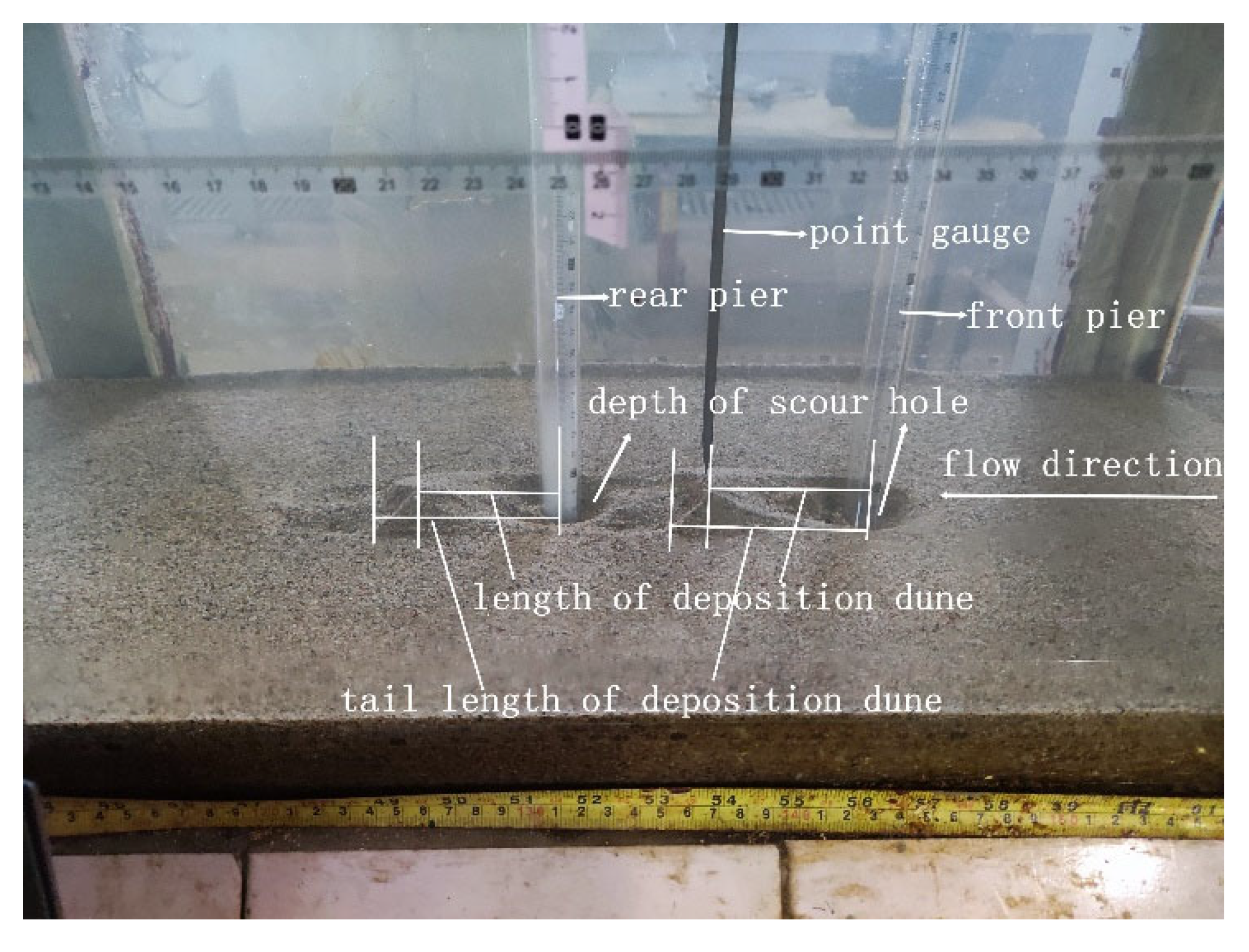
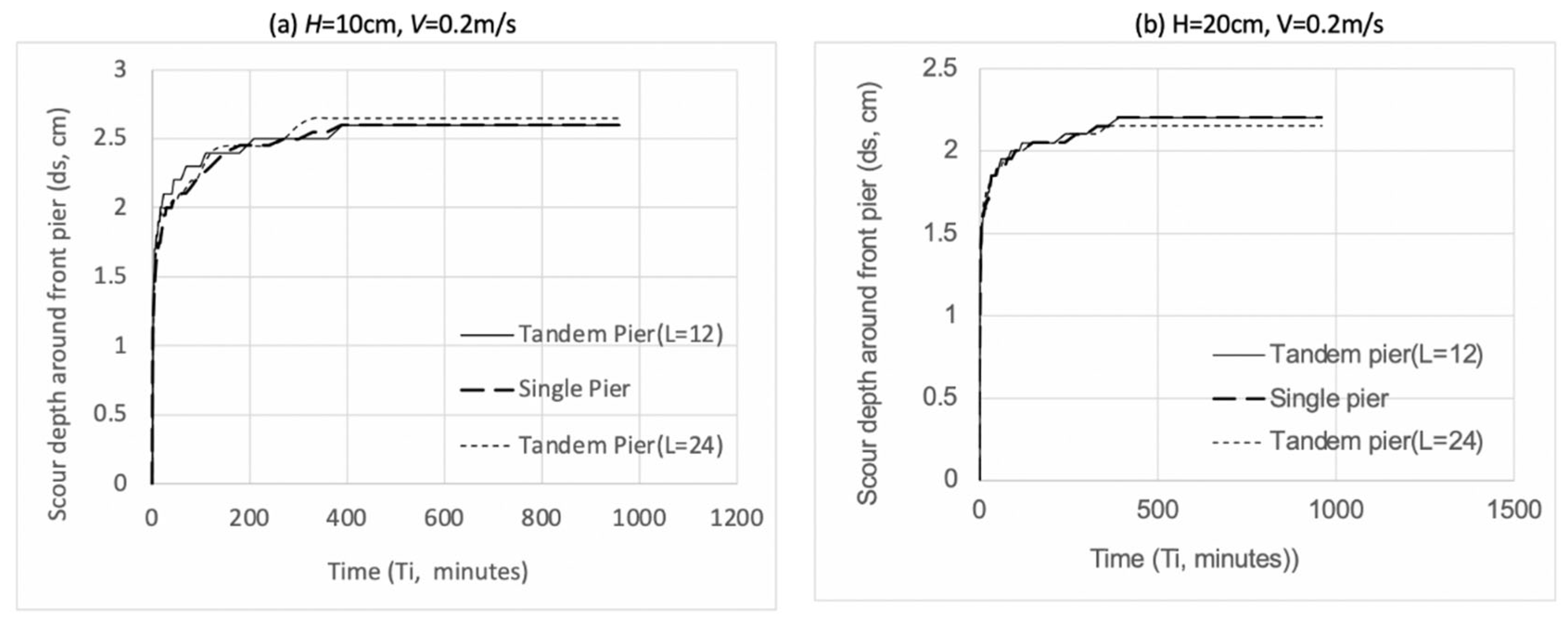
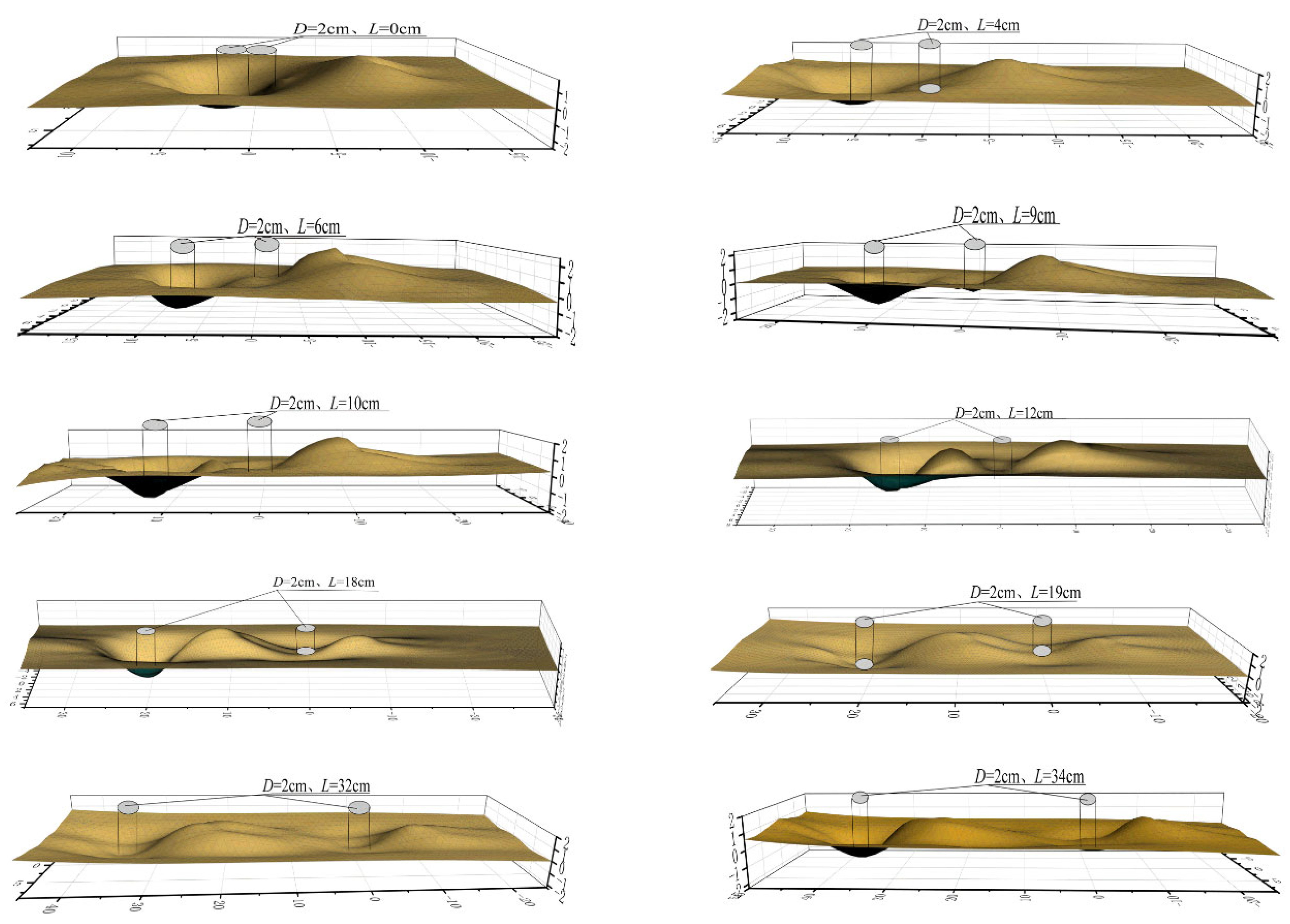
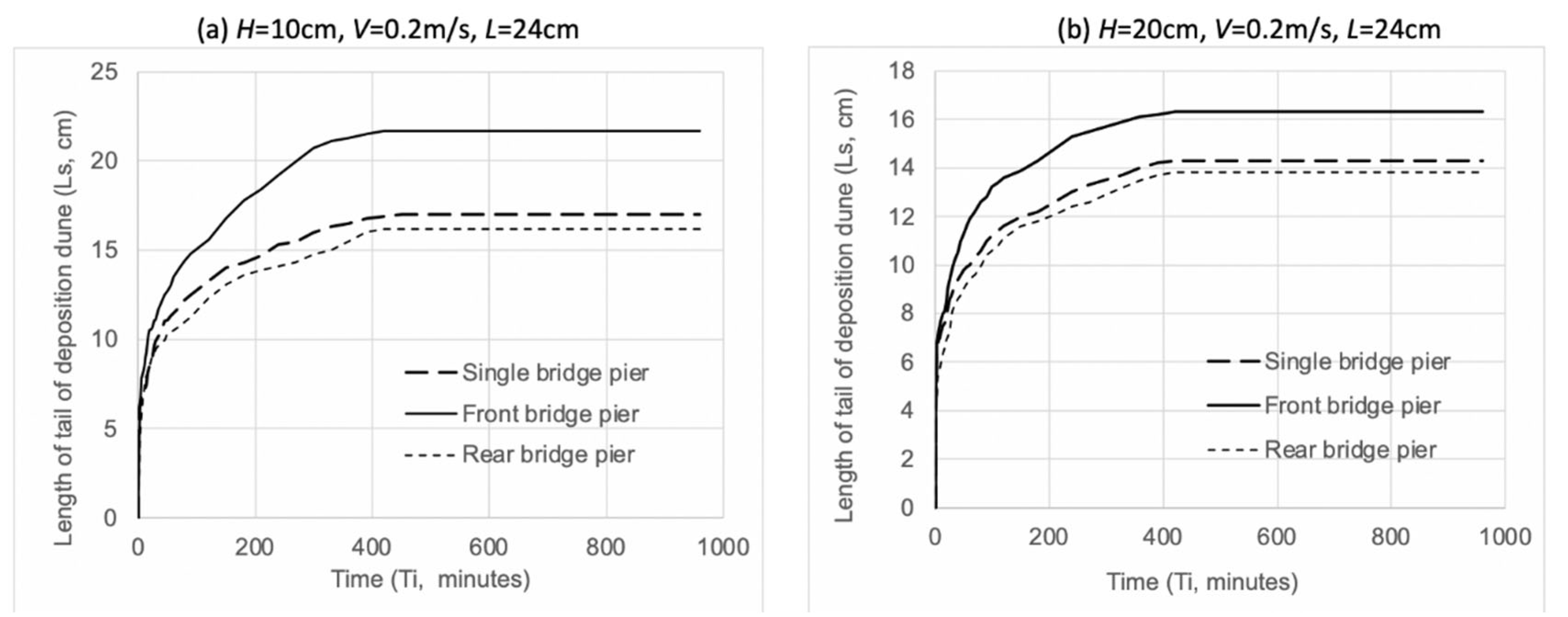
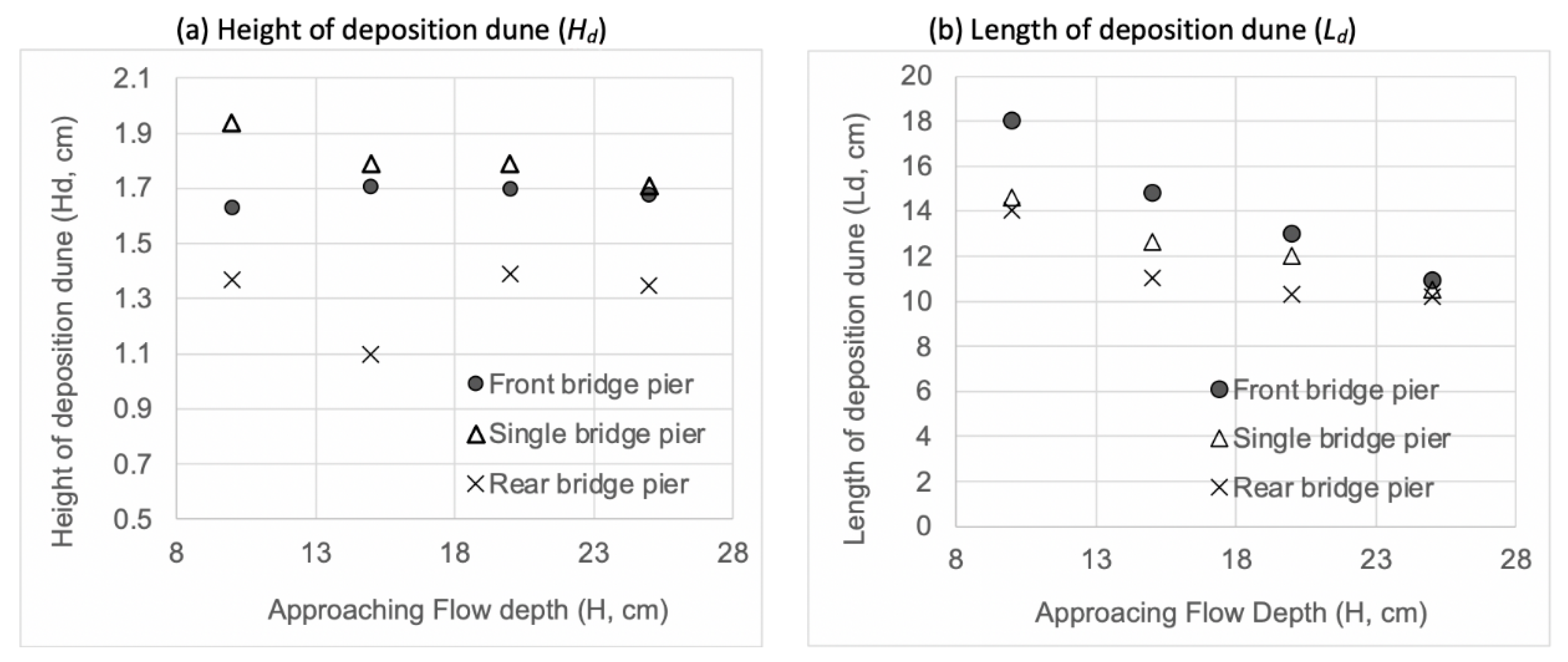
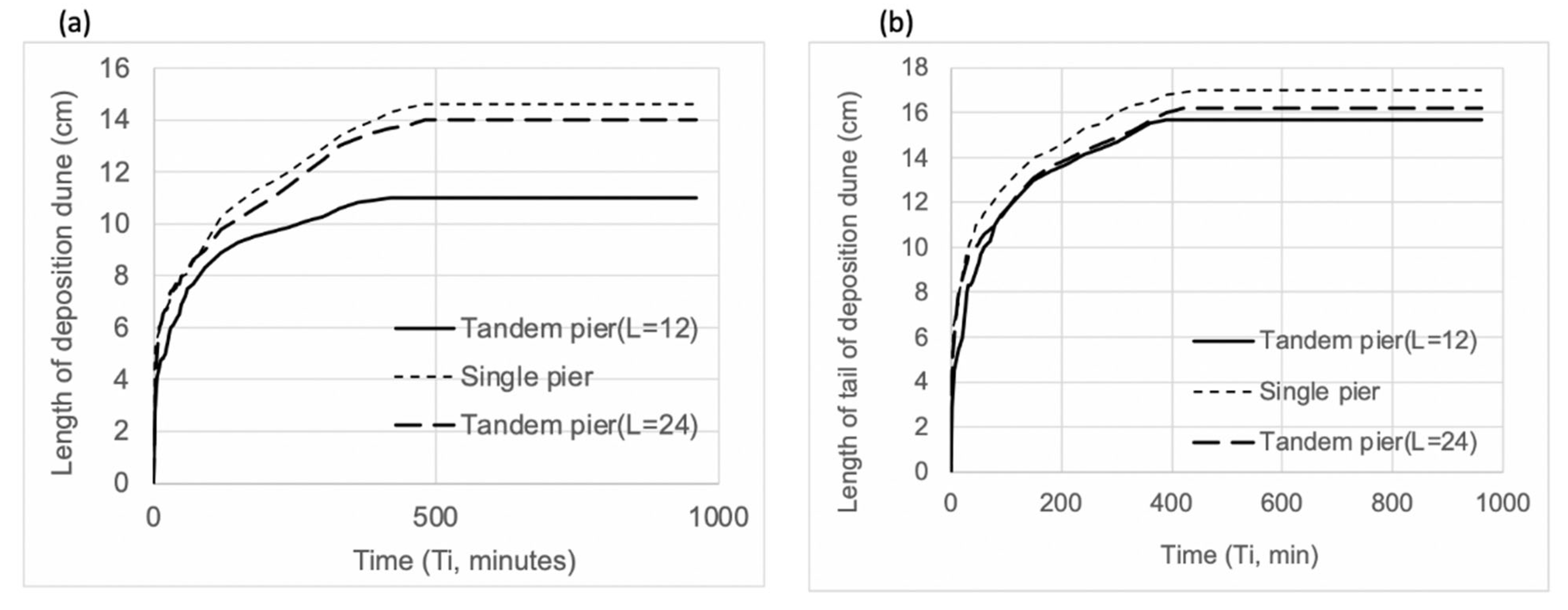
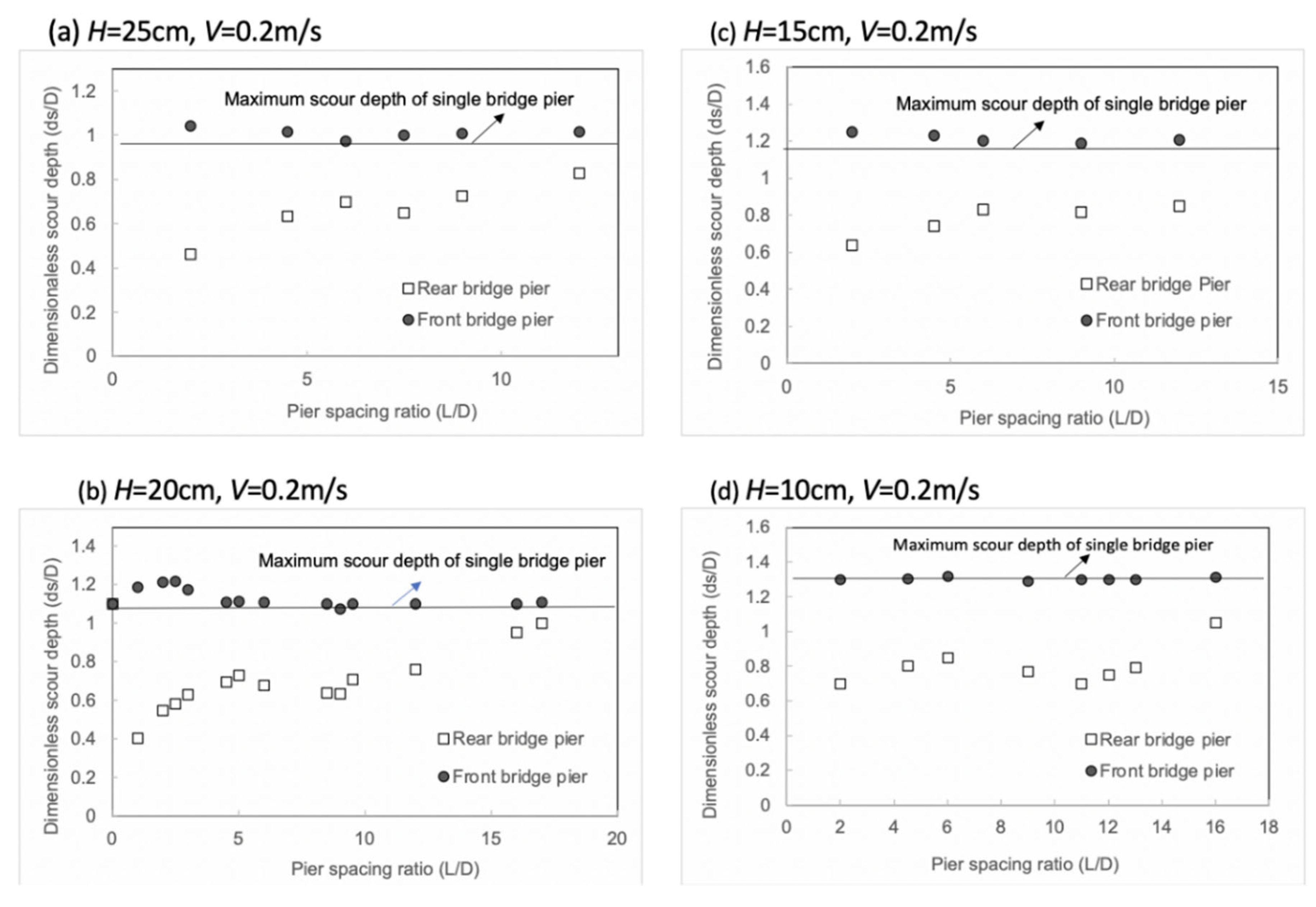
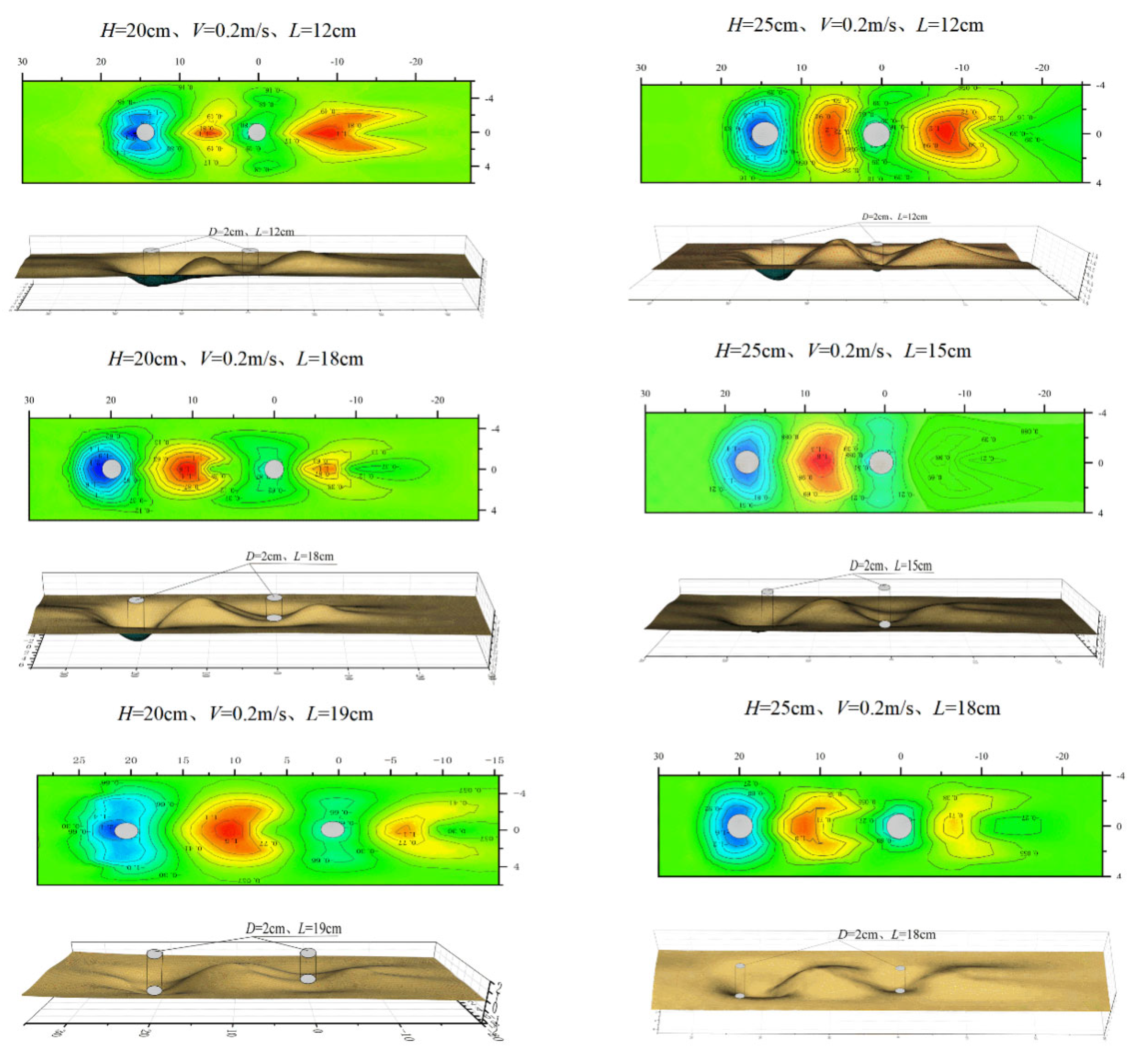
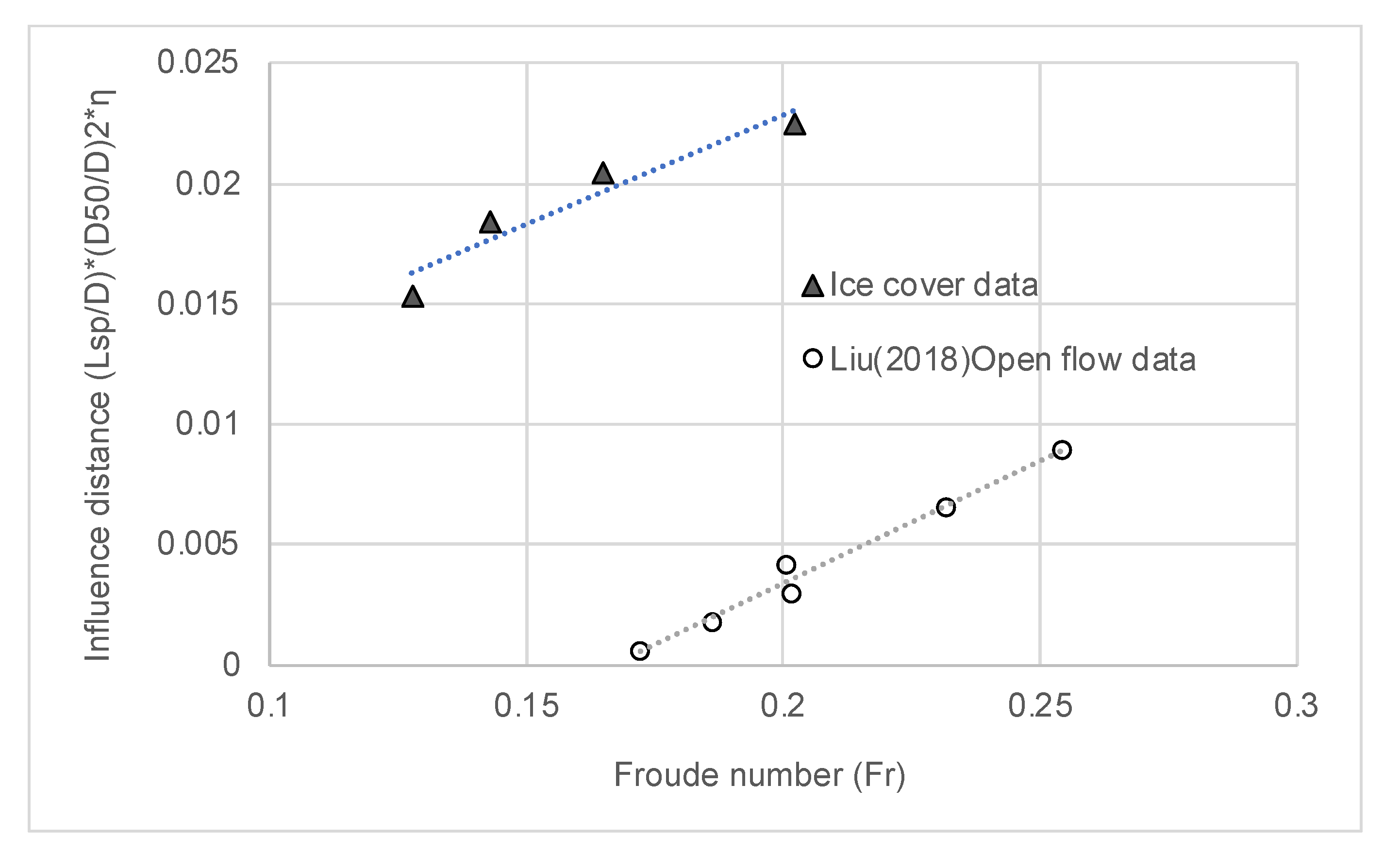
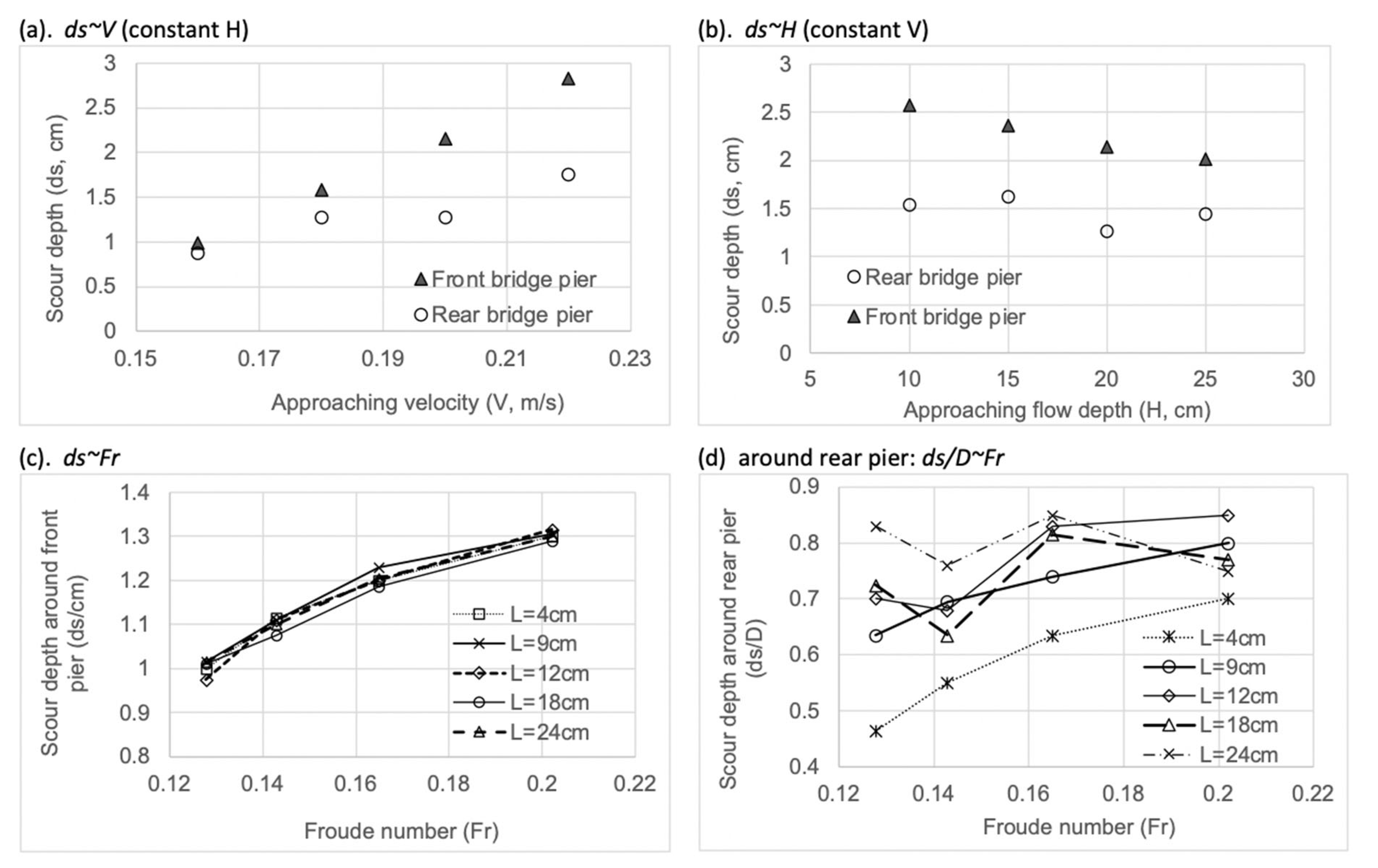
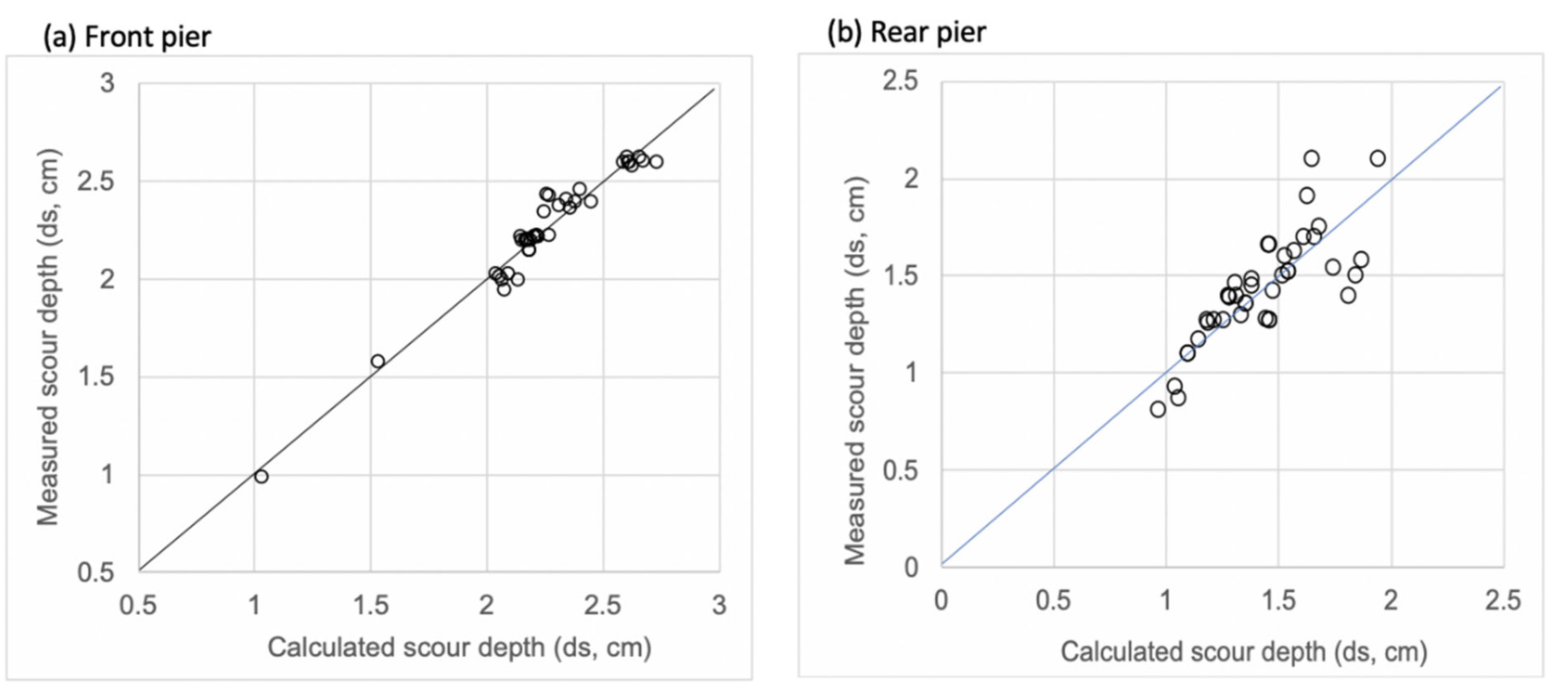
| Serial Number | V (m/s) | H (m) | D (m) | L (m) | Serial Number | V (m/s) | H (m) | D (m) | L (m) |
|---|---|---|---|---|---|---|---|---|---|
| A1 | 0.2 | 0.1 | 0.02 | — | A21 | 0.2 | 0.2 | 0.02 | 0.09 |
| A2 | 0.2 | 0.1 | 0.02 | 0.04 | A22 | 0.2 | 0.2 | 0.02 | 0.10 |
| A3 | 0.2 | 0.1 | 0.02 | 0.09 | A23 | 0.2 | 0.2 | 0.02 | 0.12 |
| A4 | 0.2 | 0.1 | 0.02 | 0.12 | A24 | 0.2 | 0.2 | 0.02 | 0.17 |
| A5 | 0.2 | 0.1 | 0.02 | 0.18 | A25 | 0.2 | 0.2 | 0.02 | 0.18 |
| A6 | 0.2 | 0.1 | 0.02 | 0.22 | A26 | 0.2 | 0.2 | 0.02 | 0.19 |
| A7 | 0.2 | 0.1 | 0.02 | 0.24 | A27 | 0.2 | 0.2 | 0.02 | 0.24 |
| A8 | 0.2 | 0.1 | 0.02 | 0.26 | A28 | 0.2 | 0.2 | 0.02 | 0.32 |
| A9 | 0.2 | 0.1 | 0.02 | 0.32 | A29 | 0.2 | 0.2 | 0.02 | 0.34 |
| A10 | 0.2 | 0.1 | 0.02 | — | A30 | 0.2 | 0.25 | 0.02 | — |
| A11 | 0.2 | 0.15 | 0.02 | 0.04 | A31 | 0.2 | 025 | 0.02 | 0.04 |
| A12 | 0.2 | 0.15 | 0.02 | 0.09 | A32 | 0.2 | 0.25 | 0.02 | 0.09 |
| A13 | 0.2 | 0.15 | 0.02 | 0.12 | A33 | 0.2 | 0.25 | 0.02 | 0.12 |
| A14 | 0.2 | 0.15 | 0.02 | 0.18 | A34 | 0.2 | 0.25 | 0.02 | 0.15 |
| A15 | 0.2 | 0.15 | 0.02 | 0.24 | A35 | 0.2 | 0.25 | 0.02 | 0.18 |
| A16 | 0.2 | 0.2 | 0.02 | — | A36 | 0.2 | 0.25 | 0.02 | 0.24 |
| A17 | 0.2 | 0.2 | 0.02 | 0.02 | B1 | 0.16 | 0.2 | 0.02 | 0.18 |
| A18 | 0.2 | 0.2 | 0.02 | 0.04 | B2 | 0.18 | 0.2 | 0.02 | 0.18 |
| A19 | 0.2 | 0.2 | 0.02 | 0.05 | B3 | 0.22 | 0.2 | 0.02 | 0.18 |
| A20 | 0.2 | 0.2 | 0.02 | 0.06 | — | — | — | — | — |
| Serial Number | Maximum Depth of Scour Hole | Maximum Length of Scour Hole | Maximum Height of Deposition Dune | Maximum Length of Deposition Dune | ||||
|---|---|---|---|---|---|---|---|---|
| Front Pier | Rear Pier | Front Pier | Rear Pier | Front Pier | Rear Pier | Front Pier | Rear Pier | |
| A1 | 2.63 | — | 10.4 | — | 1.94 | — | 14.6 | — |
| A2 | 2.6 | 1.4 | — | — | — | 2.06 | — | 13 |
| A3 | 2.61 | 1.6 | — | — | — | 2.15 | — | 13.5 |
| A4 | 2.63 | 1.7 | 10 | — | 1.1 | 1.46 | — | 11 |
| A5 | 2.58 | 1.54 | 11.7 | — | 2.02 | 1.53 | 16 | 12.2 |
| A6 | 2.6 | 1.4 | 11.7 | — | 2 | 1.46 | 14.5 | 14 |
| A7 | 2.6 | 1.5 | 11.5 | — | 1.63 | 1.37 | 18 | 14 |
| A8 | 2.62 | 1.58 | 12.3 | 9.5 | 1.76 | 1.37 | 16.7 | 13 |
| A9 | 2.6 | 2.25 | 10.4 | 8.7 | 1.9 | 1.74 | 15 | 12.7 |
| A10 | 2.42 | — | 8.8 | — | 1.79 | — | 12.6 | — |
| A11 | 2.5 | 1.27 | — | — | — | 1.73 | — | 14 |
| A12 | 2.46 | 1.48 | 11 | — | — | 1.77 | — | 15 |
| A13 | 2.4 | 1.66 | 10.8 | 7.1 | 0.93 | 1.53 | — | 16.3 |
| A14 | 2.37 | 1.63 | 9.2 | 4.6 | 1.72 | 1.12 | 16.2 | 14.7 |
| A15 | 2.41 | 1.7 | 10.2 | 8.2 | 1.71 | 1.1 | 14.8 | 11 |
| A16 | 2.2 | — | 9.7 | — | 1.79 | — | 12 | — |
| A17 | 2.43 | 1.1 | — | — | — | 1.77 | — | 11.4 |
| A18 | 2.22 | 1.39 | — | — | — | 1.98 | — | 11.1 |
| A19 | 2.22 | 1.36 | — | — | — | 2.21 | — | 10 |
| A20 | 2.15 | 1.27 | — | — | — | 2.33 | — | 9 |
| A21 | 2.2 | 1.52 | — | — | — | 2.11 | — | 9.3 |
| A22 | 2.44 | 1.17 | — | — | — | 1.86 | — | 9.9 |
| A23 | 2.35 | 1.26 | 9.3 | 6.1 | 1.32 | 1.45 | 8.7 | 9.7 |
| A24 | 2.23 | 1.46 | 9.6 | 8.3 | 1.77 | 1.37 | 9.6 | 10.2 |
| A25 | 2.2 | 1.28 | 9 | 6.3 | 1.62 | 1.04 | 10 | 9 |
| A26 | 2.2 | 1.42 | 9.3 | 6.1 | 1.83 | 1.22 | 9.5 | 7.5 |
| A27 | 2.2 | 1.91 | 8.9 | 7.3 | 1.7 | 1.39 | 13 | 10.3 |
| A28 | 2.22 | 2 | 9.4 | 8.3 | 1.9 | 1.7 | 11.5 | 9.5 |
| A29 | 2.38 | 0.81 | 9.1 | 8.1 | 1.96 | 1.78 | 11.3 | 9.6 |
| A30 | 2 | — | 8.9 | — | 1.71 | — | 10.5 | — |
| A31 | 2.09 | 0.93 | — | — | — | 1.75 | — | 6.7 |
| A32 | 2.03 | 1.27 | — | — | — | 1.76 | — | 7.7 |
| A33 | 1.95 | 1.4 | 9.4 | — | 1.38 | 1.33 | 8.2 | 9.1 |
| A34 | 2 | 1.3 | 9.6 | 6.5 | 1.58 | 1.15 | 10.4 | 7.5 |
| A35 | 2.02 | 1.45 | 9.3 | 7.3 | 1.67 | 1.16 | 10.4 | 7.5 |
| A36 | 2.03 | 1.66 | 8.5 | 7.6 | 1.68 | 1.35 | 10.9 | 10.2 |
| B1 | 0.99 | 0.87 | 6.2 | 6 | 0.78 | 0.63 | 8.1 | 7.6 |
| B2 | 1.58 | 1.27 | 6.7 | 6.3 | 1.43 | 0.98 | 7.4 | 7.3 |
| B3 | 2.83 | 1.75 | 12.3 | 7.9 | 1.35 | 1.65 | 13.5 | 18.3 |
Publisher’s Note: MDPI stays neutral with regard to jurisdictional claims in published maps and institutional affiliations. |
© 2022 by the authors. Licensee MDPI, Basel, Switzerland. This article is an open access article distributed under the terms and conditions of the Creative Commons Attribution (CC BY) license (https://creativecommons.org/licenses/by/4.0/).
Share and Cite
Sang, L.; Wang, J.; Cheng, T.; Hou, Z.; Sui, J. Local Scour around Tandem Double Piers under an Ice Cover. Water 2022, 14, 1168. https://doi.org/10.3390/w14071168
Sang L, Wang J, Cheng T, Hou Z, Sui J. Local Scour around Tandem Double Piers under an Ice Cover. Water. 2022; 14(7):1168. https://doi.org/10.3390/w14071168
Chicago/Turabian StyleSang, Liansheng, Jun Wang, Tiejie Cheng, Zhixing Hou, and Jueyi Sui. 2022. "Local Scour around Tandem Double Piers under an Ice Cover" Water 14, no. 7: 1168. https://doi.org/10.3390/w14071168
APA StyleSang, L., Wang, J., Cheng, T., Hou, Z., & Sui, J. (2022). Local Scour around Tandem Double Piers under an Ice Cover. Water, 14(7), 1168. https://doi.org/10.3390/w14071168






